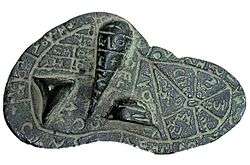Satre (Etruscan god)

Satre or Satres[1] was an Etruscan god who appears on the Liver of Piacenza, a bronze model used for haruspicy. He occupies the dark and negative northwest region, and seems to be a "frightening and dangerous god who hurls his lightning from his abode deep in the earth."[2] It is possible that Satre is also referred to with the word satrs in the Liber Linteus ("Linen Book," IX.3), the Etruscan text preserved in Ptolemaic Egypt as mummy wrappings.[3]
Satre is usually identified with the Roman god Saturn, who in a description by Martianus Capella holds a position similar to that of Satre on the liver.[4] The name Satre may be only an Etruscan translation of Saturnus,[5] or Saturnus may derive from the Etruscan;[6] it is also possible that the two deities are unrelated.[7] No image in Etruscan art has been identified as Satre: "this deity remains a riddle."[8]
References
- ↑ Satres is probably the genitive form: Giuliano Bonfante and Larissa Bonfante, The Etruscan Language: An Introduction (Manchester University Press, 2002 rev. ed.), p. 204; Susanne William Rasmussen, Public Portents in Republican Rome («L'Erma» di Bretschneider, 2003), p. 132.
- ↑ H.S. Versnel, Inconsistencies in Greek and Roman Religion: Transition and Reversal in Myth and Ritual (Brill, 1993, 1994), p. 145, citing Pliny the Elder, Natural History 2.138, 52; Massimo Pallottino, "Religion in Pre-Roman Italy," in Roman and European Mythologies (University of Chicago Press, 1992, from the French edition of 1981), p. 31.
- ↑ Bonfante, The Etruscan Language, p. 204; Jean-René Jannot, Religion in Ancient Etruria, translated by Jane K. Whitehead (University of Wisconsin Press, 2005), p. 166.
- ↑ Versnel, Inconsistencies in Greek and Roman Religion, pp. 138 (especially note 10) and 145.
- ↑ Jannot, Religion in Ancient Etruria, p. 167.
- ↑ Bonfante, The Etruscan Language, p. 204.
- ↑ As is the case with the similarly named Roman Mars and Etruscan Maris: Erika Simon, "Gods in Harmony: The Etruscan Pantheon," in The Religion of the Etruscans (University of Texas Press, 2006), p. 59.
- ↑ Simon, "Gods in Harmony," p. 59.